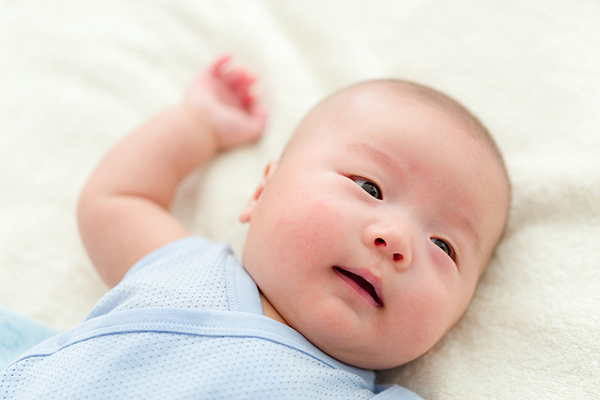
Hip Dysplasia: Why Parents Should Swaddle with Care

Swaddling a baby is a common practice. Wrapping an infant in a blanket provides a cozy cocoon that can soothe the baby and even improve sleep. However, if not done properly, swaddling could affect an infant’s tiny hips.
Wrapping a baby too tightly puts a newborn at risk of developing a condition known as hip dysplasia, according to Dr. Emily Dodwell, a pediatric orthopedic surgeon at HSS. Basically, it means the infant’s hip does not grow properly.
To understand what happens, think of the hip as a "ball-and-socket" joint. In a normal hip, the ball at the top part of the thigh bone fits firmly into the socket, which is part of the pelvis. When a baby has hip dysplasia, it can range from mild to severe. The ball may be loose in the socket or it may partially come out of the socket. Sometimes it dislocates out of the socket completely. The condition is often referred to as “developmental dysplasia of the hip” or DDH.
The Correct Way to Swaddle a Baby
Parents and caregivers are advised to take special care when wrapping their bundle of joy. “Some haven’t heard about the new swaddling recommendations, and on occasion we still see babies who have been swaddled incorrectly,” Dr. Dodwell says.
“We now know that tightly wrapping an infant’s legs could lead to hip dysplasia, so we recommend a newer, better way of swaddling,” she adds. “The safe way is to use a sleep sack that leaves lots of room for the legs, or, if using a blanket, we advise parents to keep it loosely folded around the baby’s legs so there’s room for them to bend and move apart.”
Risk Factors for Dysplasia and the Need for Screening
Swaddling isn’t the only potential cause of hip dysplasia. In fact, most of the time the condition is present at birth, occurring in one in 100 babies to varying degrees. Affecting five times as many girls as boys, it usually occurs in a healthy, normal child.
Often, a pediatrician detects dysplasia during the first hospital exam or a subsequent well-child visit. But since it’s not always apparent during the physical exam, Dr. Dodwell says babies with certain risk factors should have an ultrasound exam to check for the condition. A screening ultrasound should be conducted in the following cases:
- If there’s a family history of hip dysplasia, especially in a parent or sibling. The condition has a strong genetic component, and parents should be sure to tell their pediatrician if any close family members had it.
- If the baby was in the breech position for a good part of the third trimester.
- If there were any abnormal findings on the physical exam such as looseness of the hips, a difference in leg lengths or uneven folding of the skin around the thighs.
- If the baby is found to have a curved foot or tightness of the neck muscles.
The Ultrasound Exam
Approximately 1 in 10 babies has looseness of one or both hips at birth or a risk factor that necessitates an ultrasound screening to check for dysplasia. About 1 in 100 babies ends up needing treatment.
A recent study showed that treatment is most successful if started by 7 weeks of life, so pediatric orthopedic surgeons generally recommend obtaining a screening ultrasound by the time the baby is 6 weeks old, according to Dr. Dodwell.
She notes that the accuracy of ultrasound testing depends to a large degree on the skills of the person obtaining the images. Highly trained, experienced ultrasound technicians and specialized radiologists at Hospital for Special Surgery ensure that the exam is done properly. Pediatric orthopedic surgeons interpret the images to ensure an accurate diagnosis.
Hip Dysplasia – From Mild to Severe
In mild cases of dysplasia, the hip socket is a bit too shallow. In severe disease, the ball of the hip joint may be completely outside of the socket. Surprisingly, even with a dislocation, the baby typically does not have pain.
“If a baby has untreated hip dysplasia, it could cause more serious problems as they get older,” Dr. Dodwell says. “With the more severe form, which is a complete dislocation of the hip, they can end up with an abnormal way of walking, they can develop hip or back pain later on, and they could potentially need a hip replacement at an early age. Even those with untreated mild dysplasia may be more likely to develop arthritis and hip pain in their teens or early adulthood, and they may need surgery.”
Treatment for Hip Dysplasia
In babies under six months of age, hip dysplasia is usually treated with a soft brace that looks somewhat like suspenders. The Pavlik Harness, which is most commonly used, holds the legs in the correct position for hip development.
Babies older than six months with the condition are more likely to require a procedure under anesthesia or a bigger surgical treatment followed by a body cast for six to 12 weeks.
Dr. Dodwell emphasizes that it’s best for the baby if dysplasia is diagnosed and treated early on. Timely treatment gives the baby’s hip the best chance of developing normally.

